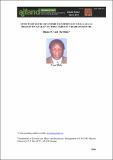| dc.description.abstract | The small-scale fisheries and fish trade sector is important in global and national economies by providing millions with income and consumers with food. Nile perch (Lates niloticus), Nile tilapia (Oreochromis niloticus), and small cyprinid (Rastrineobola argentea) form the basis of commercial fishery in Lake Victoria. From 1997 to 2000, East Africa suffered a series of fish export bans due to contamination by Salmonella, cholera epidemics and use of chemicals in Lake Victoria. Kenya thereafter adopted hygiene requirements in European directive 91/493/EEC for fish and fish products. Kenyafs fish production from the lake declined from 180,000 metric tons in 2003, down to 133,000 metric tons in 2010. Globally, 30% of total fish catch is lost through poor post harvest handling. The objectives of this study were to determine the socio-economic conditions of small-scale fish traders, to investigate hygienic practices in handling, storage and processing of fish, and to isolate and identify human pathogens in both fresh and processed fish sold in Kisumu markets. A structured questionnaire was used to get demographic, socio-economic, safety and
quality practices information. Samples of fresh and processed fish were tested for Aerobic Plate Count, Coliform, Escherichia coli and Vibrio cholerae counts. Results revealed that women traders were 81% in number while men were 19% and most of the traders (40%) were aged between 26 and 35 years. The highest level of education attained by majority (51%) of the traders was primary level. The tradersf most frequent income was KES 200-399 (USD 3 to 5) a day which cannot sustain a family. Most traders (57%) had additional sources of income to subsidise their needs. Many
traders lacked good transport, refrigeration facilities, water, toilet, waste disposal and rubbish disposal. Total plate count was above 106 per g which is the maximum allowed. The association between Total Plate Count and hygiene quality status of the samples was significant negatively at p value . 0.001. Traders should be trained on hygiene requirements and economic skills for better practices to improve business performance. | en_US |

